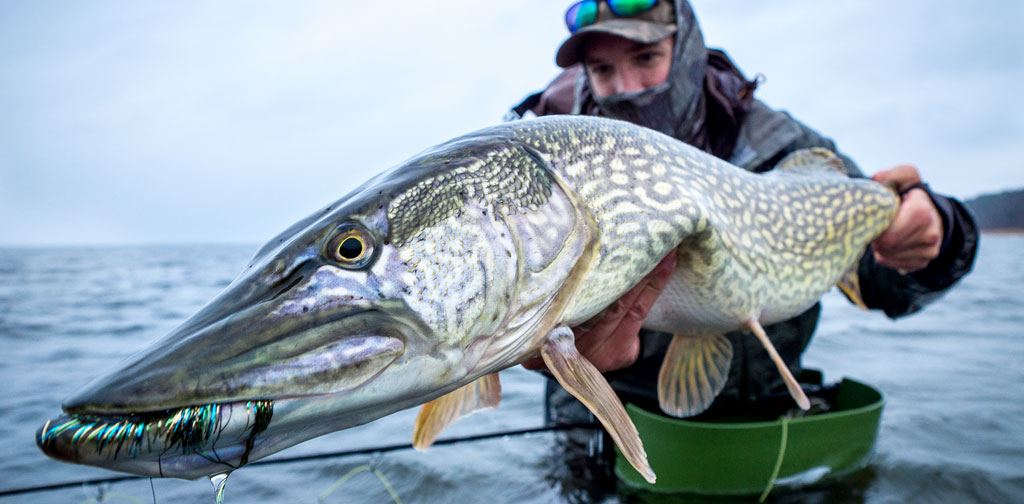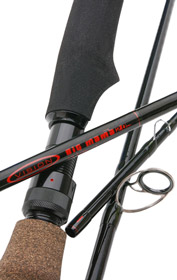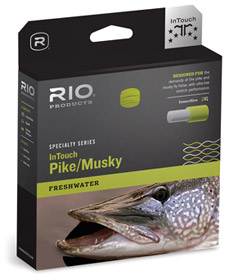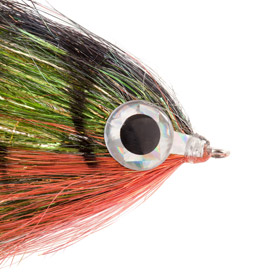Fly Fishing for Pike - Tackle and Equipment

Fly fishing for pike is booming! And not just since shows like ‚Fly vs. Jerk‘ on YouTube became popular. For a long time now ‚Esox lucius‘ is much more than just an alternative without an adipose fin while trout are spawning. Reasons are versatile: In contrast to healthy salmonid waters you can find rivers, channels and lakes which hold pike nearly everywhere. And also across the boarder (e.g. in the Netherlands or Denmark) there are a lot of first class pike waters waiting to be discovered. But first of all pike fishing is fascinating and it’s difficult to find a bigger fish that close to your front door catchable with a fly. Their behaviour is mostly aggressive, their takes are explosive and quite often spectacular. Admitted, pike fishing in nasty weather can be tough and challenging. Especially those ‚Big Mamas‘ sometimes act like a bitchy diva … but when conditions are good and pike are feeding you’ll be rewarded with an adrenalin rush which is addictive! And besides that: The chance catching a meter+ fish on the fly should be motivation enough to head to the water even when it’s cold and raining cats and dogs. Don’t you think?
In this article and in another one published soon we’ll take a closer look at fly fishing for pike. You’ll receive a lot of information, so that you are well prepared for your first pike adventures. In a first step we discuss the tackle you need and how to combine rod and line best. We show several ways of how to build a safe pike leader, which flies you can use and which equipment and accessoires you need when beeing out on the water. In a second step we'll explain the typical characteristics of different pike waters and which tactics and techniques are the most successful.
What do you need to fish for pike?
In the Netherlands and Belgium pike fishing with the fly has a very long tradition. Still today you’ll find fly fishermen using the same effective patterns already fished over 30 years ago. Classic streamers like the ‚Pikers Point‘, tied without extra weight and just with a small amount of bucktail, were fished with great success on light tackle and with ordinary fly lines on close range in small channels (so called ‚Polders‘). Due to the constant developement of carbon fibers and because more and more specialized fly lines were created, the possibilities for fly fishermen increased rapidly: Suddenly it was possible to cast big, heavy and bulky streamers on longer distance. There are nearly no boundaries anymore. Even deeper waters can nowadays be fished with a fly.
Basic characteristics of a pike rod?
The example above shows, that choosing a pike rod means deciding what kind of streamer you wanne fish/cast. You can fight a pike with a 7-weight rod without facing any problems. Unless you’re on a open water on a boat/float tube and there’s a massive fish on the other side of your sinking line which you have to pump up to the surface. In that case a 10-weight would be much more suitable.

A allround rod for pike therefor typically comes in class 8 or 9. We recommend a 9-weight in most cases. Besides its specific casting weight the rod’s action plays a major role too. Ideally the rod has a progressive action, which means that the more it bends the more the power comes from the lower part of the blank. When casting longer distances or using bulky streamers that’s as important as beeing able to drill a pike fast and gently. Especially when casting weighted patterns it’s better to open the loop a bit, so that chances of touching your blank with the streamer are reduced to a minimum. Especially when fishing in heavy winds that’s a precious tipp :) So, it's obvious that in pike fishing it’s not about tight loops. Those fishermen fighting hard for the last inch in range don’t have many advantages. Besides preferring a progessive action over a tip action, it’s nice to have a fast or medium fast rod. It’ll help you to set the hook more directly and cast into the wind without ease.
8 out of 10 fishermen choose a 9 ft. pike rod. A slightly longer rod makes just sense when you’re constantly sitting close to the water surface or wading deep up to your chest all the time aiming for distance. Slightly shorter rods instead play there advantages on small waters, when room is limited and it’s all about precise presentations on short range, e.g. when fishing tiny channels or placing a smaller, less weighted fly under branches, bridges and next to structures in the water. There are some interesting models with 8,8 ft. on the market, e.g. Loop's 'Pike Booster'.
More and more brands have reacted to the needs of pike fishermen during the last years and have created special and robust rods for their own needs (e.g. Vision 'Big Daddy 2.0‘ and 'Big Mama 2.0‘, Loop 'Pike Booster‘ or Airflo 'Green Tooth’). But there are also some great saltwater rods on the market which don’t just do a fine job when fishing for bonefish, permit or tarpon. Rods like the Scott ‚Meridian’ or ‚Tidal‘, Hardy ‚Zephrus SWS’, Loop ‚Evotec Cast Fast’ or Guideline ‚RSi’ offer great quality and feature all the characteristics you're looking for.
Fly line or shooting head?
After deciding which rod to pick you can think about your new pike line. Like any fly fisherman going for sea trout on the coast you’ll have two basic possibilities: a classic fly line or a shooting head?
Shooting heads come with a big advantage: you can change them due to the loop to loop connection quite easy and fast. The runningline, coated or just made of monofilament, stays on the reel. Therefor it’s also more convenient! But at the same time the topic gets more complex, because ideally shooting heads are customized for a specific rod and a specific fishing scenario. There is no such thing as THE shooting head. But as a rule of thumb you can keep the following in mind: When fishing for pike you’re shooting head shouldn’t be too long. A length of 7 to 8,5 m is typical and whith such a short head your streamer reaches horizon without false casts.
Like ordinary fly lines also shooting heads are available with different sinking rates - from floating variations up to sink8 heads. ‚Sink 8‘ means, that the head will sink 8 inches per second (about 20 cm). When fishing in the summer time of shortly after the spawning period, when pike hold still in the shallows, you mostly need a floating head. But during the best part of the season in fall and winter an intermediate shooting head is a must-have. If you want to fish gaps, drop-offs and want to adress pike in depths up to 5 m, a fast sinking head in combination with an intermediate running line are great to have too. By the use of that setup you can present your streamer close to the bottom but still keep in touch with its movements while stripping. You can react to a sudden strike by setting the hook instantly. An interesting alternative are ready made gradual shooting heads, e.g. from intermediate to sink2 to sink4 (Guideline ‚Triple D Power Shooting Head‘). As you can see, there are no boundaries when it comes to customizing you’re own shooting head :)
When you know your pike water and are aware about the different depths you want to fish and furthermore know which length is most suitable and which weight is perfect for your own pike rod, then there are not many arguments against using shooting heads! A well combined sortiment of shooting heads gives you freedom and flexibility. There’ll be no unpleasant surprises!
If you need assistance choosing the perfect shooting heads for your pike rod or need some help fixing nice loops to your head, you know where to find us :) Especially for beginners or those fishermen who don't have any experiences with shooting heads from other fishing scearios (salmon or sea trout fishing), that topic can be confusing. In the beginning even frustrating. There are not many shooting heads especially made for single handed fly rods. Most of them are orignally intented to be used on double handed rods and just cut to the lengths and weights needed.

Having a closer look at the classic fly lines you’ll see that there are nowadays also a lot of different possibilities for pike fishing. But the good thing is: The most important characteristics of those special pike lines are nearly the same. All of them are WF lines (weight forward) and their belly is short. Big streamers can be casted with these more aggressive tapers much easier, even in heavy wind. A head length of 8 - 10 m is typical. Only when you have to cast far very far and present the fly more sensitive at the same time, you can think about going for a longer belly (e.g. Vision ‚Big Mama‘ with 12,8 m in #9). Those lines are - as shooting heads too - available from floating variations to fast sinking variations. And although one needs a second reel or a spare spool when switching to another sinkrate, those classic lines are still overall more popular. Especially when getting started in the pike business. For many people out there, casting a regular fly line is much more fun. Besides, there are ways to change the depth of your fly by the use of an extra weight on the leader. We’ll discuss that further below.
The right leader for your fly
Whether you’re going for a shooting head or a regular fly line… you’ll need a propper leader! But how does a trust worthy pike leader look like? Which different materials can be used to build a leader and is it better to buy a ready made wire or rig up your own pike tooth protection?
In a detailed article we’ve discussed those questions one year ago ('Do you fish the best bite guard for pike?'). Since then not much has changed. It’s up to you and your personal taste wheather your fluorocarbon or nylon leader is protected by a piece of titanium, wire or hard-mono. You still have to decide for yourself if you wanne knot it, weld it or use traditional clamps and a special plier.
Classic streamers

One of our personal favorits, which we use on different kind of waters for a quite a while now, is made like that: First you pick an untapred piece of FC with a diameter of 0.45 to 0.65 mm. The bigger your streamer, the thicker the fluorocarbon. The diameter of the material supports the leaders ‚turnover‘. When fishing with a sinking line a piece of 50 to 75 cm is more than enoug. Otherwise you’ll create a belly in the leader while fishing and loose direct contact to your streamer. And even worse: Your streamer rides much higher than the fly line, which has the tendency to spook fish. On an intermediate or floating line the FC can be longer, between 1 and 2 m, depending on the fishing pressure, water clearness etc.
After choosing the right length you connect the FC to a piece of titanium (z.B. ‚Knot2Kinky‘ with 11,36 kg). You can use a ‚Albright Knot’ for that connection. The knot is very durable, discret and won’t pick up much weed. A big advantage on highly frequented waters and when targeting big pike, which have seen a lot in their life. You’re classic streamer can be attached afterwards with a ‚Non-Slip Mono Knot‘ or a ‚Perfection Loop‘. In case you wanne be able to switch to another streamer without tying a new know, you can use a propper snap inbetween. And don’t be afraid: Even though it looks stiff at a first glance, titanium is very flexible and less fragile than ordinary wire - e.g. after several pike attacks or when you got stuck.
Tube streamers
Unfortunately this setup is not ideal for all the different streamers out there. Why? Besides streamers tied onto a hook directly (2/0 to 6/0 are typical sizes), there’s a trend which results in new rigs and setups. We’re talking about tube flies. The idea to tie the pattern onto a plastic tube (without a hook) is well known from salmon fishing since years.
Fishing with a tube streamer has some major advantages: On the one hand you can combine one fly with different hooks or replace the hook in case it’s not sharp anymore. When fishing for pike you can also think about attaching a big streamer to a special rig consisting of a big hook and a small trailing hook. Especially when pike are not in the mood to go for the head, such a ‚stinger hook‘ is invaluable! To build up such a rig you just place a titanium loop through the eye of the small hook and secure it with your tying thread and some super glue on the big hooks shank.
On the other hand you can experiment with tube flies more easily, without investing much money and time. You can for example pimp your hook rig with rattles. An effective acoustical stimulus for lazy winter pike! Furthermore the average life of a tube streamer is longer. Due to the fact, that hook is just put into the tube. When thegrabs the fly and you set the hook via your line correctly, the pike pulls the hook out of the tube and sets the pattern free, unharmed from 700 razor sharp tooth!
For these kind of streamers we also recommend a special leader, made from plastic coated wire (e.g. Vision ‚Pike Wire‘). The video by Niklaus Bauer below, one of the pioneers of tying pike tubes, shows how to build a safe leader in just a few steps and without much materials used.
Let’s sum it up: You find pike streamers tied on tubes or on hooks directly. Classic streamers receive their weight already on the vice. The weight helps to get down much quicker and some lead or a bead also add a jigging effect to your streamers movements. Tubes are normally not weighted, besides an UV or epoxy finish. But you can put a conehead (there are different diameters, weights and colors available) on the wire leader to tweak the action of your fly. Of course they can be used for those classic patterns as well. In addition you create a clicking sound, everytime bead and streamer hit each other whilst stripping the line back to you. You can be pretty sure that this will get the pikes attention!
Another current hype are so called ‚Wiggle Tails‘. A kind of twister tail made from synthetic materials, available in different sizes, shapes and colors. They develope a nice play and are attached to the fly by the use of special snaps. That way you can change them quickly and easily. The video below shows how rigs for Wiggle Tails are prepared.
With a assortment of confidence flies in your box and some leaders and rigs in your pocket you’re nearly ready to rumble! What’s still missing is a reel and some last accessoires.
Which role plays the reel?
Let’s be honest. Actually it’s not that important which reel you pick to store your new pike line. Of course pike takes are ruthless and can hit you like a slap in the face out of nowhere. But in contrast to saltwater fishing or fishing for salmon there are no such things like furious first runs. In the pike world, your reel's breaking system plays a minor role in the game. Having a solid reel, capable of storing a thick floating line and some backing and balancing your rod perfectly is more than enough. Only when you fish in brackish waters constantly, you can choose a model with rustproof components.
And what else?
- Stripping basket: When fishing from a boat or wading, a stripping basket is very useful. Your line doesn’t get tangled up and can be shot to the horizon much easier.
- Gloves: On the most waters, the best period for ‚Big Mamas‘ usually starts when temperatures drop for the first time. Pike weather is commonly nasty and therefor fingerless gloves are nice to have. Besides, they are protecting your fingers. After stripping a thin line all day long over your forefinger or middle finger, you know what we’re talking about :) It can be a bloody surprise.
- Stripping guards: Those protective finger sleeves made of a thin synthetic material are a cheap alternative to gloves. Not just very common in saltwater fishing!
- Pliers: It will happen frequently that a pike fully inhales your fly and it’s sitting deep down in the jaw, right inbetween 700 sharp tooth. In these cases it’s not just important that you know how to handle a pike by grabbing it correctly, but you also have a long plier at hand. You’re fingers will be thankful.
- Polarized sungalsses: How crucial a good pair of polarized glasses is we discussed in a long article earlier this year (Polarized sungalsses and fly fishing). Also when fishing for pike your eyes need some protection; from dangerous uv-light as well as from strayed streamers.
These very useful accessoires complete your pike outfit! To make your start into the pike world even easier, we arrange suitable kits for pike fishing on a regular basis.
Now you need to know how to take your fly to the pike. Which tactics and techniques are really efficient and how you succeed on different kind of waters. These aspects will be discussed in our soon to be published second article on the topic of pike fishing on the fly.


















































































































